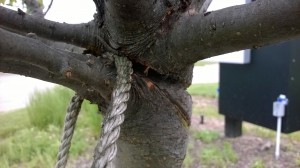We see newly planted trees that have stakes to “help support the tree” all the time. And many times people will see other trees being staked, and they think, I will stake the new tree that I am going to plant because that is what everyone else is doing. I recommend against that idea. I will explain why.
When at Michigan State, we covered staking trees. There are two rules when it comes to staking trees, and here they are:
- Don’t stake any tree.
- If your tree falls over or is leaning, correct the lean, then stake your tree on the up-wind side only. Leave the stake in place for no longer than one year.
The point here is: trees do not need staking. By staking a tree, you are giving the tree extra support. That sounds good right? No, the tree will become dependent on the stake to support itself and will struggle to grow strong enough to get rid of the stakes. This can cause problems later when the tree is under stress (wind, drought, etc.) and the tree is at a higher risk of damage.

When you do need to stake a tree, make sure that the tree has room to flex and grow. The stake should be on the up-wind side of the tree to give it help when the wind that knocked it down in the first place comes again, the tree will have some help. Make sure that the stake is on the tree for less than one year. Leaving the support on for too long can eventually damage the tree by girdling the trunk as well as creating a dependance for support.
It is best to not stake your tree. Only do so as a last resort to keep the tree standing. The tree will thank you in the long run if it is not staked by being a tree that supports itself.